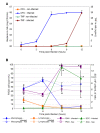Osteopontin: an early innate immune marker of Escherichia coli mastitis harbors genetic polymorphisms with possible links with resistance to mastitis
- PMID: 19765294
- PMCID: PMC2761946
- DOI: 10.1186/1471-2164-10-444
Osteopontin: an early innate immune marker of Escherichia coli mastitis harbors genetic polymorphisms with possible links with resistance to mastitis
Abstract
Background: Mastitis is the most important disease in dairy cows and it causes significant lost of profit to producers. Identification of the genes, and their variants, involved in innate immune responses is essential for the understanding of this inflammatory disease and to identify potential genetic markers for resistance to mastitis. The progeny of dairy cows would benefit from receiving favourable alleles that support greater resistance to infection, thus reducing antibiotic use. This study aims to identify a key gene in the innate immune response to mastitis, led us to evaluate its genetic association with somatic cell score (SCS), which is an indicator of clinical mastitis, and to evaluate its impact on other traits related to milk production.
Results: The osteopontin transcript (SPP1) was identified in the somatic cells from cows experimentally infected with Escherichia coli. By selecting bulls with extreme estimated breeding values (EBVs) for SCS, which is an indicator of mammary gland health, four DNA polymorphisms in the SPP1 genomic sequence were found. Statistical analysis revealed that the SNP SPP1c.-1301G>A has an impact on EBV for SCS (P < 0.001) Using an allele substitution model, SPP1c.-1251C>T, SPP1c.-430G>A, and SPP1c.*40A>C have an impact on SCS whereas SPP1c.-1301G>A has an effect on the EBVs for milk yield (second and third lactations), fat and protein percentages (all three lactations). Analysis revealed statistically significant differences between haplotype groups at a comparison-wise level with sire EBVS for SCS for the first (P = 0.012), second (P < 0.001), and third (P < 0.001) lactations.
Conclusion: This study reports the link between DNA polymorphisms of SPP1, the number of milk immune cells and, potentially, the susceptibility to mastitis. These SNPs were identified by in silico search to be located in transcription factor recognition sites which factors are presumably involved in the Th1 immune response and in the Th2 regulation pathway. Indeed, one SNP abolished the SP1 recognition site, whereas another SNP affected the transcription binding factor IKAROS. All together, these findings support the genetic potential of these variants in terms of selection for the improvement of mastitis resistance in dairy cows.
Figures


References
-
- Sordillo LM, Shafer-Weaver K, DeRosa D. Immunobiology of the mammary gland. J Dairy Sci. 1997;80:1851–1865. - PubMed
Publication types
MeSH terms
Substances
LinkOut - more resources
Full Text Sources
Medical
Research Materials
Miscellaneous

